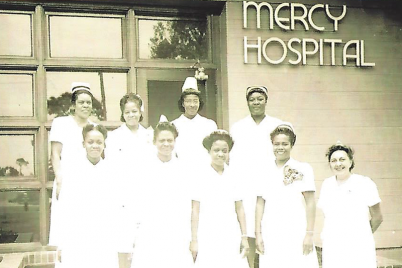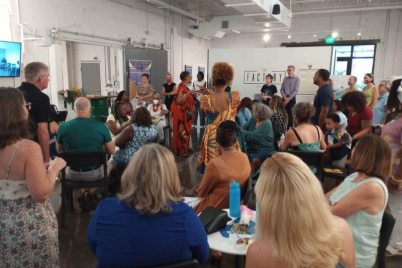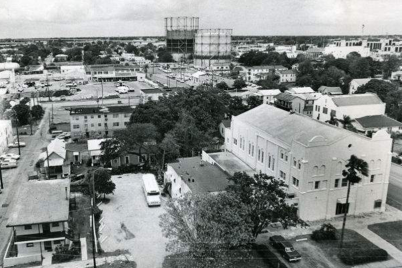On Jan. 21, the MLK Day of Service, the African American Heritage Association invited young and old to First Baptist Institutional Church for an afternoon of fellowship, good food, and, most of all, history.
BY HOLLY KESTENIS | Staff Writer
ST. PETERSBURG – The African American Heritage Association has selflessly volunteered countless hours to preserve some of the local St. Petersburg history. What makes this history so unique is its meaning for the community, especially the African Americans residing in south St. Pete.
“It took a lot to get her here,” Gwen Reese, Chair of the African American Heritage Association, confided, discussing her mother, who was reluctant to show. “She wanted to stay home and watch the inauguration.”
But Reese knows the importance of bringing the community together to share stories, even if it means turning off the television because these are stories you usually don’t hear about. Stories of what life was like for so many African Americans during the days of segregation and racial tensions.
So, on the MLK Day of Service, the Heritage Association invited young and old to First Baptist Institutional Church, 3144 Third Ave. S, for an afternoon of fellowship, good food, and, most of all, history.
“If Dr. Martin Luther King had sat down, where would we be today?” Reese asked those in attendance. “This is our opportunity to get up, to do something, to provide a service.”
For nearly a year, the African American Heritage Association has been working toward preserving the rich African-American history in St. Petersburg. They realized that many of today’s younger generation lack knowledge of essential traditions and the meaning behind African-American customs.
“That’s part of what we should do as the elders in the community,” Reese explained after a beautiful rendition of “Lift Every Voice and Sing,” the Negro National Anthem. “Not only should we help our students know their history, they should also know songs that are important to us.”
So, to preserve and keep alive the struggles and triumphs of the last century, the African American Heritage Association asked those with a story to tell to enlighten the community with their memories.
Paul Stewart was one of the first elders to come forward to speak. Born in Savannah, Ga., he spent all three weeks there before moving south.
“I know nothing about Savannah,” he said as he reminisced about his early years in St. Petersburg. “[This] is my home. I grew up here.”
Stewart grew up under his mother’s watchful eye, a long-time educator in Pinellas County, and his grandparents. Now at 65, Stewart boasts about being a member of the graduating class at Gibbs High School in, you guessed it, 1965.
Growing up mainly in the Campbell Park neighborhood, he is no stranger to hard times, but you wouldn’t know it from his stories. Even though he grew up during the 1950s when segregation was the norm in St. Petersburg, Stewart didn’t spend his moment in the spotlight on Monday depicting the struggles he and his family inevitably experienced. Instead, he concentrated on the positive memories in his life that sometimes came from adversity, bringing a smile to the many faces of his listeners.
Painting a picture of Campbell Park’s old terrain, he educated attendees on how life used to be in this area. Instead of the swimming pool that currently resides near 14th Street, he said there used to be a ballpark. Behind that and down the hill a way, he fondly remembers the property of Mr. Walker.
“We would sneak and steal the sugar cane out of [his] factory,” Stewart confessed with a laugh, “but you had to make sure he didn’t come out of his house with his pellet gun because he would shoot you.”
Once the chuckles faded, he got to talking baseball. It was an exciting time for Stewart as a youngster. He met, dined, and even slept next to some of greats. In today’s time, he would be the envy of all his pals. Back then, well, he still was the envy of all his friends, but the circumstances weren’t ideal. Because of staunch segregation, black ballplayers couldn’t stay in hotels with their white counterparts, so they had to find lodging in the “black neighborhoods.”
His grandmother stepped up to the plate and played host to an array of young talent siphoning through the St. Petersburg area during spring training sessions—athletes such as Curt Flood, Bill White and Roberto Clemente. With so many needing places to stay, already crowded dwellings overflowed with little room left over for those who lived there.
“Most of the family slept on rollaway beds in the hallway because the ballplayers had the bedroom,” he explained.
But everyone made due, and Stewart never complained. One of his fondest memories was during middle school. Stewart distinctly remembered each time the Pirates would visit to play the Cardinals. It would be a frantic four days, and families had to always double up lodgings, with his cousins even hosting players, but it always brought good times and good food.
“They all came to my grandmother’s for dinner,” he bragged, stating that even players staying in other houses would swing by and grab a bite to eat.
During the Cardinals’ stay, Stewart would make himself useful by washing the expensive cars of visiting players. He reminisced on his first thoughts upon seeing Frank Robinson’s white El Dorado, which he’d just won for being the most valuable player, parked in their driveway.
“I would charge my buddies a nickel to help me wash their cars,” he joked, bringing his audience to tears of laughter. “We would sit in Frank’s car and smell the leather. I remember that.”
And even though the pleasure of sitting in famous baseball players’ hot rods was enough for Stewart, he still was paid a dollar for his services.
“You could get sick buying candy if you got a dollar,” he explained. “That was unheard of; you never had a dollar to buy that much candy.”
Stewart finished reciting his snippets of history as all good storytellers do, with just the right amount of humor and with a person he grew to admire, Cardinal Roberto Clemente. Yet another famous ballplayer to share his room with, they would sit on opposite twin beds facing each other, and Clemente would share the events of his day. At the time, Clemente spoke very little English and would spend evenings trying to translate.
“He would try to remember little things to explain what he should have said,” Stewart recalled as he recanted how he tried to help. “Those are the kinds of memories I have.”
Paul Stewart’s historical recollection is part of a four-part series dedicated to African-American history here in St. Petersburg.










